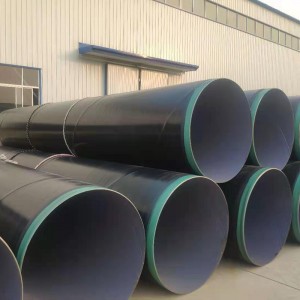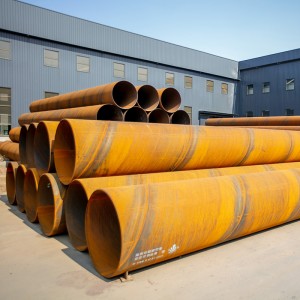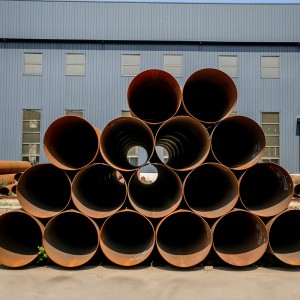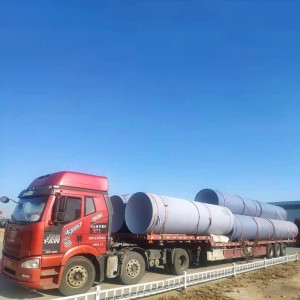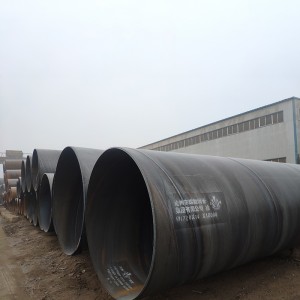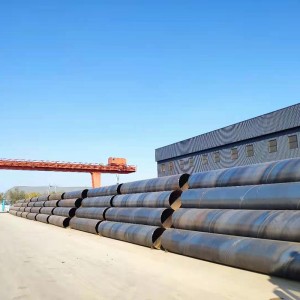High Quality Spiral Seam Pipe
Introducing our high-quality spiral-seam pipe, a product that embodies strength, durability and precision engineering. Made using an advanced spiral welding process, our pipes are manufactured from hot-rolled steel coils that are carefully formed into a cylindrical shape and welded along the spiral seam. This innovative manufacturing technique not only enhances the structural integrity of the pipes, but also ensures they can withstand the most demanding applications.
At our company, we pride ourselves on our unwavering commitment to customer satisfaction. Over the years, we have built a reputation for excellence by prioritizing our customers' needs at every stage of the purchasing process. From pre-sales consultation to in-sales support and comprehensive after-sales services, we are committed to meeting the every need of our customers. This customer-centric approach has earned us the trust and loyalty of our customers, who always appreciate the quality of our products and the reliability of our services.
Our high-quality spiral seam pipe is suitable for a variety of applications, including construction, oil and gas, and marine transportation. With its superior strength and durability, it is designed to withstand pressure and resist corrosion, making it a long-lasting solution for your piping needs.
Product Specification
|
Main Physical and Chemical Properties of Steel Pipes (GB/T3091-2008, GB/T9711-2011 and API Spec 5L) |
||||||||||||||
|
Standard |
Steel Grade |
Chemical Constituents (%) |
Tensile Property |
Charpy(V notch)Impact Test |
||||||||||
| c | Mn | p | s | Si |
Other |
Yield Strength(Mpa) |
Tensile Strength(Mpa) |
(L0=5.65 √ S0 )min Stretch Rate (%) |
||||||
| max | max | max | max | max | min | max | min | max | D ≤ 168.33mm | D > 168.3mm | ||||
|
GB/T3091 -2008 |
Q215A | ≤ 0.15 | 0.25 < 1.20 | 0.045 | 0.050 | 0.35 |
Adding NbVTi in accordance with GB/T1591-94 |
215 | 335 | 15 | > 31 | |||
| Q215B | ≤ 0.15 | 0.25-0.55 | 0.045 | 0.045 | 0.035 | 215 | 335 | 15 | > 31 | |||||
| Q235A | ≤ 0.22 | 0.30 < 0.65 | 0.045 | 0.050 | 0.035 | 235 | 375 | 15 | >26 | |||||
| Q235B | ≤ 0.20 | 0.30 ≤ 1.80 | 0.045 | 0.045 | 0.035 | 235 | 375 | 15 | >26 | |||||
| Q295A | 0.16 | 0.80-1.50 | 0.045 | 0.045 | 0.55 | 295 | 390 | 13 | >23 | |||||
| Q295B | 0.16 | 0.80-1.50 | 0.045 | 0.040 | 0.55 | 295 | 390 | 13 | >23 | |||||
| Q345A | 0.20 | 1.00-1.60 | 0.045 | 0.045 | 0.55 | 345 | 510 | 13 | >21 | |||||
| Q345B | 0.20 | 1.00-1.60 | 0.045 | 0.040 | 0.55 | 345 | 510 | 13 | >21 | |||||
|
GB/T9711-2011(PSL1) |
L175 | 0.21 | 0.60 | 0.030 | 0.030 |
Optional adding one of NbVTi elements or any combination of them |
175 | 310 |
27 |
One or two of the toughness index of impact energy and shearing area may be chosen. For L555, see the standard. |
||||
| L210 | 0.22 | 0.90 | 0.030 | 0.030 | 210 | 335 |
25 |
|||||||
| L245 | 0.26 | 1.20 | 0.030 | 0.030 | 245 | 415 |
21 |
|||||||
| L290 | 0.26 | 1.30 | 0.030 | 0.030 | 290 | 415 |
21 |
|||||||
| L320 | 0.26 | 1.40 | 0.030 | 0.030 | 320 | 435 |
20 |
|||||||
| L360 | 0.26 | 1.40 | 0.030 | 0.030 | 360 | 460 |
19 |
|||||||
| L390 | 0.26 | 1.40 | 0.030 | 0.030 | 390 | 390 |
18 |
|||||||
| L415 | 0.26 | 1.40 | 0.030 | 0.030 | 415 | 520 |
17 |
|||||||
| L450 | 0.26 | 1.45 | 0.030 | 0.030 | 450 | 535 |
17 |
|||||||
| L485 | 0.26 | 1.65 | 0.030 | 0.030 | 485 | 570 |
16 |
|||||||
|
API 5L (PSL 1) |
A25 | 0.21 | 0.60 | 0.030 | 0.030 |
For grade B steel,Nb+V ≤ 0.03%;for steel ≥ grade B,optional adding Nb or V or their combination, and Nb+V+Ti ≤ 0.15% |
172 | 310 |
(L0=50.8mm)to be calculated according to the following formula:e=1944·A0 .2/U0 .0 A:Area of sample in mm2 U: Minimal specified tensile strength in Mpa |
None or any or both of the impact energy and the shearing area is required as toughness criterion. |
||||
| A | 0.22 | 0.90 | 0.030 | 0.030 | 207 | 331 | ||||||||
| B | 0.26 | 1.20 | 0.030 | 0.030 | 241 | 414 | ||||||||
| X42 | 0.26 | 1.30 | 0.030 | 0.030 | 290 | 414 | ||||||||
| X46 | 0.26 | 1.40 | 0.030 | 0.030 | 317 | 434 | ||||||||
| X52 | 0.26 | 1.40 | 0.030 | 0.030 | 359 | 455 | ||||||||
| X56 | 0.26 | 1.40 | 0.030 | 0.030 | 386 | 490 | ||||||||
| X60 | 0.26 | 1.40 | 0.030 | 0.030 | 414 | 517 | ||||||||
| X65 | 0.26 | 1.45 | 0.030 | 0.030 | 448 | 531 | ||||||||
| X70 | 0.26 | 1.65 | 0.030 | 0.030 | 483 | 565 | ||||||||
Product Advantage
1. One of the main advantages of spiral seam pipe is its excellent strength. The spiral welding process enables continuous welding, thereby enhancing the structural integrity of the pipe. This makes them ideal for transporting fluids and gases under high pressure.
2. The manufacturing process is efficient, allowing longer pipes to be produced without the need for joints, which can be potential weak points.
3. Another significant advantage of helical seam pipe is its versatility. They can be produced in a variety of diameters and wall thicknesses for a wide range of applications from oil and gas transportation to water systems.
4. The companies that manufacture these pipes prioritize customer satisfaction and provide comprehensive pre-sales, during-sales, and after-sales services. This commitment ensures customers receive products tailored to their specific needs, enhancing the overall experience.
Product shortcoming
1. The spiral welding process can be more complex than traditional welding methods, which can result in higher production costs.
2. While spiral seam pipes are strong, they may be less resistant to certain types of corrosion than other pipe materials and require protective coatings or treatments.
FAQ
Q1:What is spiral seam pipe?
Spiral seam pipe is constructed using a specialized method called the spiral welding process. This innovative technology involves hot-rolled steel coils being formed into a cylindrical shape and welded along a spiral seam. The resulting pipe not only has high strength but also excellent durability, making it ideal for a variety of applications, including oil and gas transportation, water supply and structural support.
Q2:Why choose high quality spiral seam pipe?
The main advantage of high-quality spiral seam pipes is their strong construction. The spiral welding process allows for continuous welding, which enhances the integrity and pressure resistance of the pipe. In addition, these pipes can be manufactured in a variety of sizes and thicknesses to meet the specific needs of different projects.
Q3:What should I look for in a supplier?
When choosing a spiral seam tubing supplier, it is critical to select a company that places customer satisfaction first. Look for a supplier that offers comprehensive pre-sales, sales, and after-sales services. A reputable company will ensure that its products meet established specifications and can accommodate your unique requirements, ensuring that you receive high-quality products and services that your customers will appreciate.


